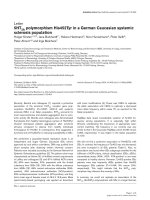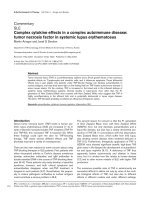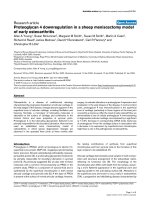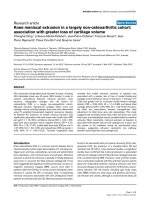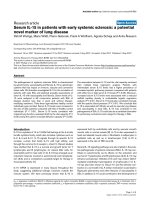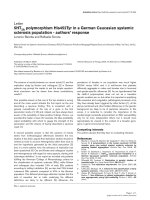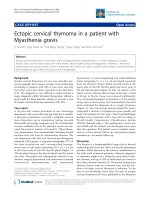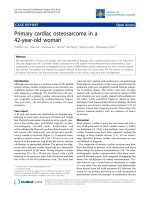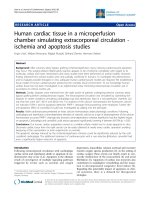Báo cáo y học: "5HT2A polymorphism His452Tyr in a German Caucasian systemic sclerosis population" ppt
Bạn đang xem bản rút gọn của tài liệu. Xem và tải ngay bản đầy đủ của tài liệu tại đây (45.33 KB, 2 trang )
Available online />Page 1 of 2
(page number not for citation purposes)
Recently, Beretta and colleagues [1] reported a protective
association of the serotonin 5-HT
2A
receptor gene poly-
morphism His452Tyr (C+1354T, rs6314) with systemic
sclerosis (SSc) in an Italian population. 5HT
2A
accounts for
most vasoconstrictive and platelet aggregation due to sero-
tonin activity [2]. Beretta and colleagues also demonstrated
that plasma from healthy heterozygous carriers of His452Tyr
showed decreased platelet aggregation after serotonin
stimulus compared to plasma from healthy individuals
homozygous for His452. In consequence, they suggested a
functional role of His452Tyr in reducing susceptibility to SSc.
We performed a population-based replication study in an
independent and larger German Caucasian SSc cohort,
approved by local ethics committees. DNA was purified from
blood samples after obtaining written informed consent.
Patients were included according to the German Network for
Systemic Scleroderma guidelines [3]. The patient cohort was
characterised as follows [4]: all fulfilled minimal requirements
of LeRoy and colleagues [5] and 81% fulfilled ACR criteria
[6]; 80% were females, 50% presented with the limited
cutaneous form (lSSc [3]), 33% with the diffuse cutaneous
form (dSSc [3]), 89% carried antinuclear antibodies (ANA-
positive), 43% anticentromere antibodies (ACA-positive),
39% antitopoisomerase I antibodies (ATA-positive), and they
had a mean age of disease onset of 49.5 ± 13.8 years. Mass
spectrometry-based genotyping was applied as described,
with minor modifications [4]. Power was >96% to replicate
the allelic association and >99% to replicate a decreased
minor allele frequency within cases [7], as reported for the
Italian population.
HapMap data reveal considerable variation of Tyr452 fre-
quency among populations. It is especially high within
Africans, emphasizing the importance of appropriate case-
control matching. The frequency in our controls was very
similar to that in the Caucasian HapMap cohort (0.065 versus
0.063, respectively). It was higher in the Italian population
(0.124).
We did not find a protective association of His452Tyr with
SSc. In contrast, the frequency of Tyr452 was not decreased,
but even increased in all SSc patients (Table 1). Also, no
association was found when SSc subgroups stratified for the
fulfilment of ACR-criteria, clinical classification (lSSc, dSSc),
autoantibody status (ANA-, ACA-, ATA-positive) or sex were
compared to healthy donors. However, Tyr452-positive SSc
patients were less frequently dSSc positive than His452
homozygous SSc patients (P = 0.048, 9% versus 20%,
respectively). This might indicate that the 5HT
2A
poly-
morphism may influence the severity of SSc.
In summary, we could not replicate an association of the
5HT
2A
His452Tyr polymorphism with SSc in a larger German
Letter
5HT
2A
polymorphism His452Tyr in a German Caucasian systemic
sclerosis population
Holger Kirsten
1,2,3*
, Jana Burkhardt
1*
, Helene Hantmann
2
, Nico Hunzelmann
4
, Peter Vaith
5
,
Peter Ahnert
1,6
and Inga Melchers
7
1
Institute of Clinical Immunology and Transfusion Medicine, Center for Biotechnology and Biomedicine (BBZ), University of Leipzig, Johannisallee,
04103 Leipzig, Germany
2
Fraunhofer Institute for Cell Therapy and Immunology, Perlickstr., 04103 Leipzig, Germany
3
Translational Center for Regenerative Medicine, University of Leipzig, Phillip-Rosenthal-Str., 04103 Leipzig, Germany
4
Department of Dermatology, University of Cologne, Kerpener Straße, 50924 Cologne, Germany
5
Department of Rheumatology and Clinical Immunology, University Medical Center Freiburg, Hugstetter Str., 79106 Freiburg, Germany
6
Institute for Medical Informatics, Statistics and Epidemiology, University of Leipzig, Haertelstr. 16-18, 04107 Leipzig, Germany
7
Clinical Research Unit for Rheumatology, University Medical Center, Breisacher Str., 79106 Freiburg, Germany
*These authors contributed equally to this work.
Corresponding author: Inga Melchers,
Published: 26 March 2009 Arthritis Research & Therapy 2009, 11:403 (doi:10.1186/ar2606)
This article is online at />© 2009 BioMed Central Ltd
See related research by Beretta et al., and related letter by Beretta and Scorza,
/>SSc = systemic sclerosis.
Arthritis Research & Therapy Vol 11 No 2 Kirsten et al.
Page 2 of 2
(page number not for citation purposes)
Caucasian cohort. However, an influence of this single
nucleotide polymorphism on severity of SSc may exist.
Competing interests
The authors declare that they have no competing interests.
Acknowledgements
Support originated from the BMBF (‘German Network for Systemic
Scleroderma’ to IM and NH; ‘Hochschul-Wissenschafts-Programm’to
PA), the SAB (7692/1187) and EFRE (EFRE4212/04-04) to PA.
References
1. Beretta L, Cossu M, Marchini M, Cappiello F, Artoni A, Motta G,
Scorza R: A polymorphism in the human serotonin 5-HT
2A
receptor gene may protect against systemic sclerosis by
reducing platelet aggregation. Arthritis Res Ther 2008, 10:
R103.
2. Welsh DJ, Harnett M, MacLean M, Peacock AJ: Proliferation and
signaling in fibroblasts: role of 5-hydroxytryptamine2A recep-
tor and transporter. Am J Respir Crit Care Med 2004, 170:252-
259.
3. Hunzelmann N, Genth E, Krieg T, Lehmacher W, Melchers I,
Meurer M, Moinzadeh P, Müller-Ladner U, Pfeiffer C, Riemekasten
G, Schulze-Lohoff E, Sunderkoetter C, Weber M, Worm M, Klaus
P, Rubbert A, Steinbrink K, Grundt B, Hein R, Scharffetter-
Kochanek K, Hinrichs R, Walker K, Szeimies RM, Karrer S, Müller
A, Seitz C, Schmidt E, Lehmann P, Foeldvári I, Reichenberger F,
et al.: The registry of the German Network for Systemic Scle-
roderma: frequency of disease subsets and patterns of organ
involvement. Rheumatology 2008, 47:1185-1192.
4. Kirsten H, Blume M, Emmrich F, Hunzelmann N, Mierau R, Rzepka
R, Vaith P, Witte T, Melchers I, Ahnert P: No association
between systemic sclerosis and C77G polymorphism in the
human PTPRC (CD45) gene. J Rheumatol 2008, 35:1817-1819.
5. LeRoy EC, Black C, Fleischmajer R, Jablonska S, Krieg T,
Medsger TA Jr, Rowell N, Wollheim F: Scleroderma (systemic
sclerosis): classification, subsets and pathogenesis. J
Rheumatol 1988, 15:202-205.
6. Subcommittee for scleroderma criteria of the American Rheuma-
tism Association Diagnostic and Therapeutic Criteria Committee:
Preliminary criteria for the classification of systemic sclerosis
(scleroderma). Arthritis Rheum 1980, 23:581-590.
7. Garnier S, Dieude P, Michou L, Barbet S, Tan A, Lasbleiz S,
Bardin T, Prum B, Cornelis F: IRF5 rs2004640-T allele, the new
genetic factor for systemic lupus erythematosus, is not asso-
ciated with rheumatoid arthritis. Ann Rheum Dis 2007, 66:828-
831.
Table 1
Distribution of C+1354T within German systemic sclerosis patients and controls
Genotype C versus T
CC CT TT Total MAF OR (95%CI) P
a
Patients 176 31 2 209 0.084 1.32 (0.8-2.2) 0.28
Controls 203 28 1 232 0.065
a
P-values were calculated with Fisher’s exact test. Genotypes in cases and controls were consistent with Hardy-Weinberg equilibrium. Frequencies
of genotypes were also not significantly different between patients and controls (P = 0.52, exact Fisher Freeman Halton test). CI, confidence
interval; MAF, minor allele frequency; OR, odds ratio.
